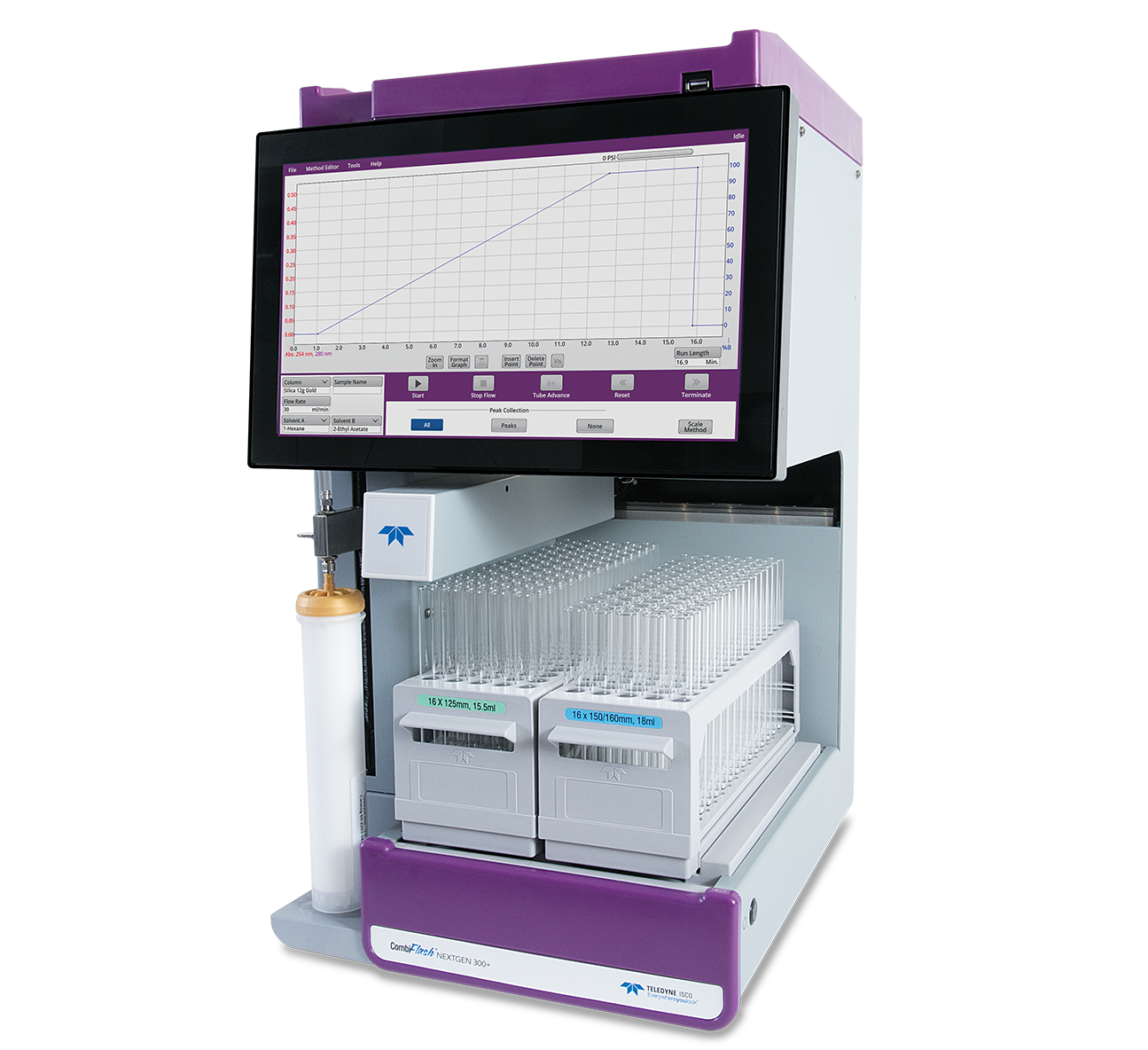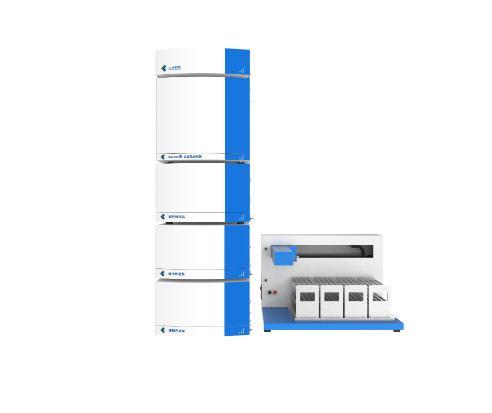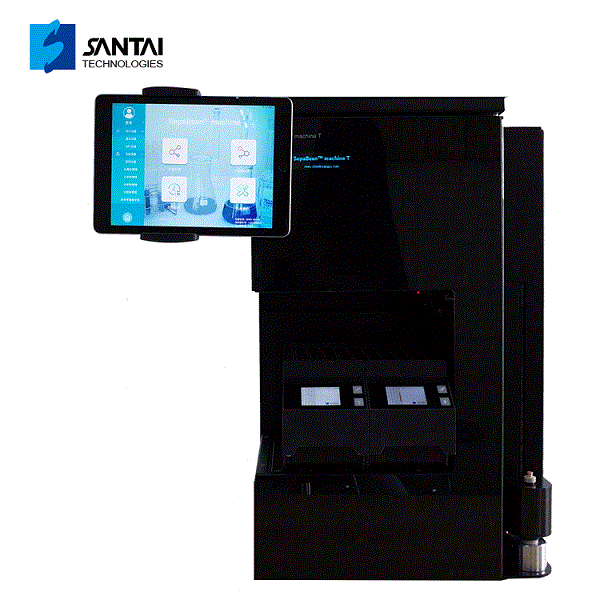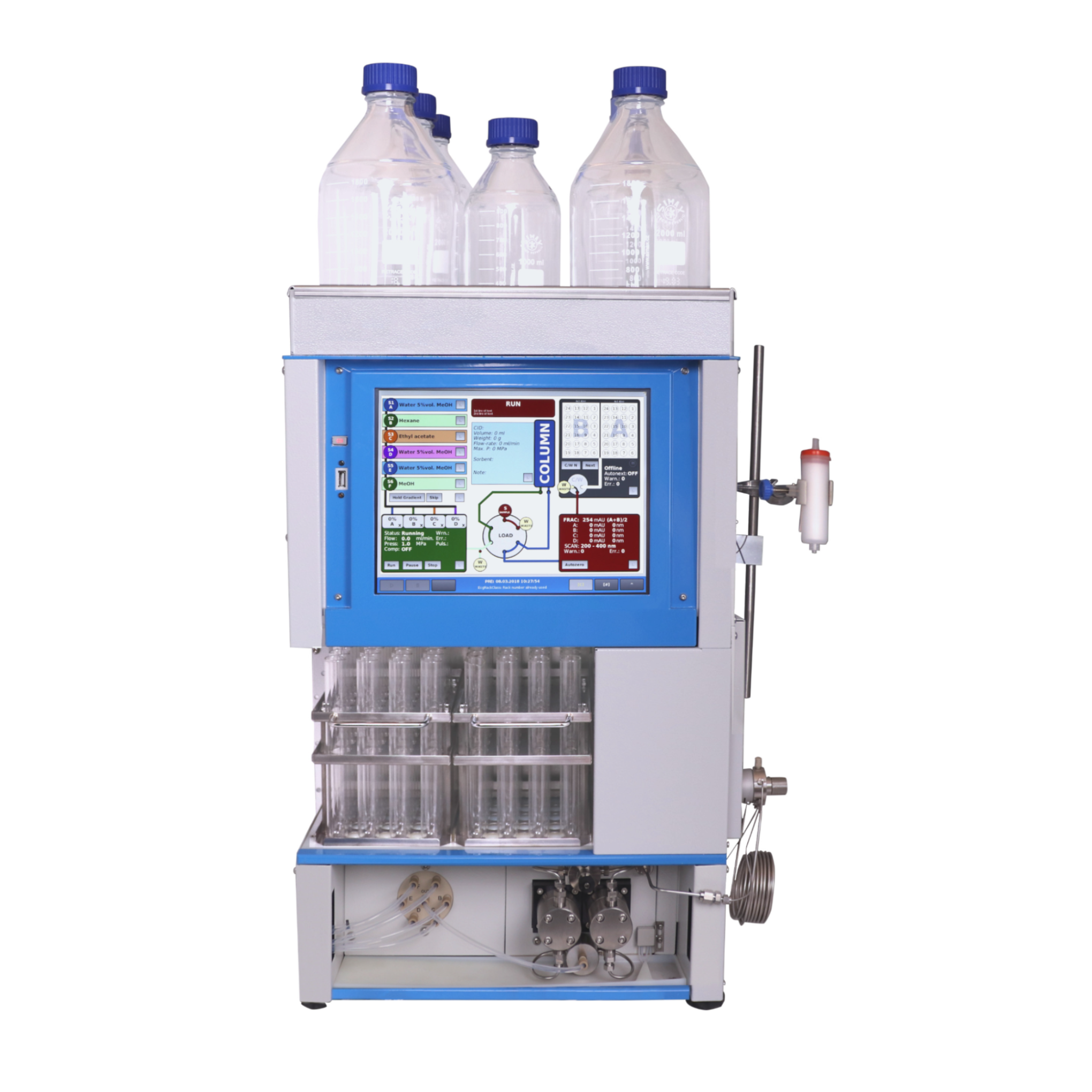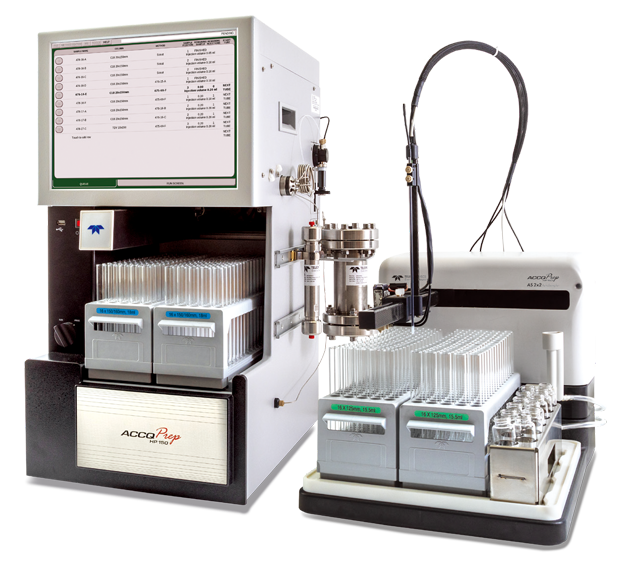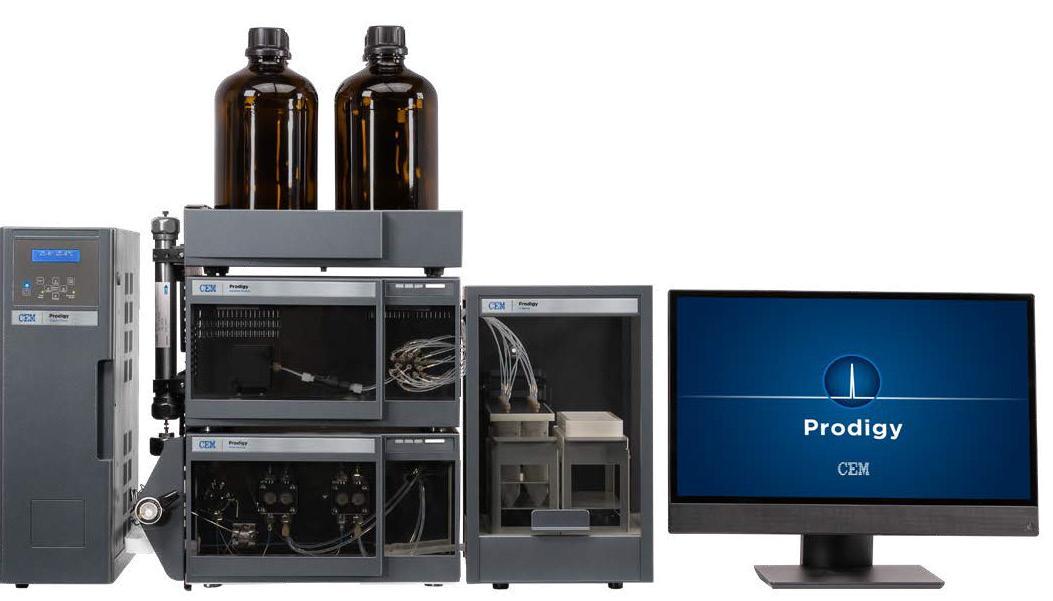在ACCQ HP150 系统使用自动聚焦梯度发生器,人们无需再花时间开发或优化闪式色谱聚焦梯度方法。从单次运行分析侦察的结果,由内置工具自动计算生成聚焦梯度, 以确定是否能够在CombiFlash NextGen 系统上有效运行特定的纯化,以及制备型 HPLC 的聚焦梯度的计算或闪式色谱的纯化。当使用 RediSep制备型HPLC色谱柱与 RediSep Gold相匹配的色谱柱,以确定样品纯化和计算闪式色谱聚焦梯度,在运行时间为7 - 12min内完成(取决于HPLC系统和所使用的色谱柱)。也可以使用分析型 HPLC 系统通过ACCQPrep 聚焦梯度生成器以计算快速色谱梯度(参见Teledyne ISCO 网站上的技术报告TN52)。
方案详情

TELEDYNE ISCOEverywhereyoulookChromatography Application NoteAN119 Chromatography Application Note AN119 Teledyne ISCOP.O. Box 82531,Lincoln, Nebraska,68501 USAToll-free:(800) 228-4373·Phone:(402) 464-0231·Fax:(402) 465-3091Teledyne ISCO is continually improving its products and reserves the right to change productspecifications, replacement parts,schematics, and instructions without notice.April 2021 Generate Reverse PhaseFlash Focused Gradientsat Lightning Speed Abstract With an automated focused gradient generator nowavailable on ACCQPrep°HP150 systems, it is nolonger necessary to spend time manually developingor optimizing flash focused gradient methods. The toolautomatically calculates the focused gradient from theresults of a single analytical scouting run. It can be usedto determine whether a particular purification will runeffectively on a CombiFlashNextGen system, and tocalculate focused gradients for preparative HPLC orflash purifications. When using RediSep° Prep HPLCcolumns with matching selectivity to RediSep Goldcolumns, determination of sample purity and calculationof the flash focused gradient is completed within 7 to 12minutes, depending on the HPLC system and columnused. Analytical HPLC systems can also be employedto calculate flash chromatography methods using theACCQPrep Focused Gradient Generator (see Tech noteTN52 on the Teledyne ISCO web site). Background Reverse phase flash chromatography has beenhindered by the lack of rapid method developmenttechniques. Normal phase flash chromatographymethod development can be done with thin layerchromatography (TLC) plates, but if the sample elutesin a solvent system containing more than 60% water,reverse phase plates take a very long time to run.Another approach is to develop the flash method directlyon the flash system, but this consumes large amounts ofsolvent and sample. Or the method can be developed onan analytical HPLC system and then transferred to theflash system, which typically involves multiple attemptsand requires analytical columns with chemistry matchingthe flash columns (as described in AN118). UsingRediSep Prep columns in conjunction with the focusedgradient generator tool in the ACCQPrep avoids all theseproblems, saving time, sample, and solvent. Further,using the flash system for the easier purifications willfree up the ACCQPrep system to run the more difficultpurifications that cannot be run with flash. Experimental and Results Use the following procedure to develop flash focusedgradients from a scouting run. 1. Run the focused gradient generator with the sampleto be purified, on the ACCQPrep. Either the built-infocused gradient generator can be used, or the toolthat calculates a focused gradient from an analyticalHPLC. If using the ACCQPrep for the scouting run,use procedure“a”. Procedure“b”uses an analyticalHPLC system calibrated with the ACCQPrep. a. Use a 20x150 mm RediSep Prep column tocalculate the focused gradient for the compoundto be purified. Note that RediSep Prep columnsmatch the column chemistry of RediSep reversephase columns, thereby avoiding differences incolumn selectivity. Record the starting and endingpoints of the focused gradient; these values will beused on the flash chromatography system. b. Make sure the ACCQPrep and analytical HPLChave been calibrated according to Tech Note TN52.Use a 2x50 mm or a 4.6x150 mm RediSep Prepanalytical column that matches the flash columnchemistry to be used, such as RediSep Gold C8,C18, or C18AQ. Enter the retention time for thepeak of interest into the ACCQPrep to calculate afocused gradient. Record the starting and yalendingpoints of the focused gradient; these values will beused on the flash chromatography system. 2. Determine whether there is enough resolutionbetween the compound to be purified and the closestimpurity. The easiest way to determine this is tocalculate a focused gradient for both the impurityand the desired compound and then note the focusedgradient starting points for each method. If thesolvent composition for the gradient starting pointfor the impurity is more than 3% B away from thatof the desired compound, the purification can berun on a flash column; otherwise the ACCQPrepsystem will be required. The difference in solventcomposition for the starting point of the gradient isused because this value will be the same whether theACCQPrep internal calculation or an external HPLCcalculation tool is used. Another way to assess therequired resolution is by the difference in retentiontime of the peaks in the scouting gradient. Determine the scouting gradient slope m=(Ending %B -Start%B)/Gradient time. For the example in Figure 1,thisis (100-5)/6=15.8. Since we require 3% resolutionto resolve the peaks on a flash column, divide 3 bythe slope. The equation is: A%B=3/m. For the6-minute gradient used in Figure 1,3/15.8=0.19,which rounds to ~0.2 minutes. This means peaksneed to be resolved by at least 0.2 minutes on thisscouting gradient to be resolved and purified on theCombiFlash NextGen system. 3. Load a column of the same type used for the scoutinggradient on the CombiFlash NextGen Using themethod editor, create a focused gradient with timeunits expressed in column volumes. Select the samesolvents as used for the scouting run, includingany modifiers. The starting and ending %B for thefocused gradient are the same as that determined bythe ACCQPrep, and the gradient length, in columnvolumes, as listed in Table 1. If a solid load cartridgeis used, the gradient length will need to be extended. 5.5 20 15.5 14 30 14 50and larger 12 Table 1-Focused gradient lengths for various flash columnsizes. The example below used a mixture of capsaicins, chosento be at the limit of resolution for flash chromatography.The first step is to perform a scouting run that allows agradient to be determined for the first eluting peak in themixture at ~7.5 minutes. A RediSep Prep 20x150 mmcolumn was used for the scouting run (PN 69-2203-810)with a water/methanol gradient. The next step is to calculate a focused gradient for thefirst eluting peak. The chromatogram is run only as anexample. The peaks in the scouting run are 0.2 minutesapart, corresponding to a difference of 3 %B in thecalculated gradients of the two compounds. Figure 2-Calculated ACCQPrep gradient for the first peakin Figure 1. A 50 g RediSep Gold C18 column (PN 69-2203-336) isinserted into the CombiFlash NextGen. After thecolumn is recognized by the system, the run parametersfor the column are loaded. The solvent system is thesame used for the scouting run. The gradient is modifiedto a focused gradient with the same starting and endingsolvent composition as for the ACCQPrep.The column iswashed with at least 2.5 CV of B solvent at the end ofthe run to purge strongly retained compounds. Figure 3-Flash focused gradient using the ACCQPrep gradientin Figure 2, with a 50 g RediSep Gold C18 column. The same gradient range is used on a 5.5 g RediSep C18column, but the gradient length is changed to 20 CV. Figure 4-Flash focused gradient using the ACCQPrep gradientin Figure 2, with a 5.5 g RediSep Gold C18 column. Conclusion Using the focused gradient generator built into theACCQPrep allows an optimized flash method to bedetermined within 12 minutes, using only the datafrom the scouting run used to evaluate sample purity.This tool also allows a user to determine in advancewhether or not there is sufficient resolution between thecompound of interest and the nearest impurity for it tobe run on a flash column, or if the higher resolution ofthe ACCQPrep is required. Given sufficient resolution,the gradient method calculated by the ACCQPrep canbe used for flash purification; otherwise it is run onthe ACCQPrep. 摘 要 在ACCQPrep® HP150 系统使用自动聚焦梯度发生器,人们无需再花时间开发或优化闪式色谱聚焦梯度方法。从单次运行分析侦察的结果,由内置工具自动计算生成聚焦梯度, 以确定是否能够在CombiFlash® NextGen 系统上有效运行特定的纯化,以及制备型 HPLC 的聚焦梯度的计算或闪式色谱的纯化。当使用 RediSep®制备型HPLC色谱柱与 RediSep Gold®相匹配的色谱柱,以确定样品纯化和计算闪式色谱聚焦梯度,在运行时间为7 - 12min内完成(取决于HPLC系统和所使用的色谱柱)。也可以使用分析型 HPLC 系统通过ACCQPrep 聚焦梯度生成器以计算快速色谱梯度(参见Teledyne ISCO 网站上的技术报告TN52)。背景反相快速色谱技术由于缺乏方法的快速开发技巧而受到阻碍,正相快速色谱方法的开发可以用薄层色谱 (TLC) 板完成,但如果样品洗脱在超过 60% 的含水溶剂系统,反相薄层板需要很长时间才能完成。另一种手段是直接在闪式色谱系统上开发方法,但这会消耗大量溶剂和样品;或者可以在分析 HPLC 系统开发方法,然后转移到闪式色谱系统,通常涉及多次尝试并且需要相匹配的分析柱和闪式快速色谱柱(如应用报告AN118 中所述)。使用配备RediSep Prep 色谱柱的ACCQPrep制备色谱上的梯度生成器工具,将避免了所有这些问题,不仅节省时间、样品和溶剂,而且对容易纯化的样品还可以使用快速制备系统进行,这将避免大量的分离纯化在高压制备完成而导致ACCQPrep 系统的工作量压力。实验和结果使用以下流程开发闪式色谱的聚焦侦察运行梯度。1、在 ACCQPrep 上运行聚焦梯度生成器,使用待纯化样本进行纯化。使用内置聚焦梯度生成器,或者分析HPLC的聚焦梯度计算工具,如果使用 ACCQPrep 进行侦察运行,则使用流程“a”。流程“b”用于使用 ACCQPrep 校准的 HPLC 系统。a、使用 20x150 mm Redisep 制备色谱柱计算需纯化的化合物的聚焦梯度。请注意,Redisep 制备色谱柱应与 RediSep 反相色谱柱化学性能相匹配,从而避免色谱柱选择性的差异。记录开始和结束聚焦梯度的点;这些值将用于快速闪式色谱系统。b、确保 ACCQPrep 和分析HPLC已根据技术说明 TN52 进行校准。使用 2 x 50 mm 或 4.6x150 mm RedisSep Prep与闪式色谱柱化学性能相匹配的分析色谱柱,例如 RediSep Gold C8,C18 或 C18AQ。输入ACCQPrep 中的目标峰保留时间来计算聚焦梯度。记录开始和结束聚焦梯度的点;这些值将用于快速色谱系统。2、判断要纯化的化合物与最接近的杂质之间是否有足够的分离度,确定这一点的最简单方法是计算杂质和目标的化合物的聚焦梯度,然后注意每种方法的聚焦梯度起点,如果杂质梯度起始点的溶剂组成与目标化合物相距超过 3% 的B,纯化可以是在闪式色谱柱上运行;否则将需要 ACCQPrep系统。起点梯度溶剂组成值的差别,不因ACCQPrep 使用内部计算或使用外部 HPLC计算工具将是相同的。另一种评估所需的分离度方法取决于侦察梯度中的峰值保留时间的差异。确定侦察梯度斜率 m = (Ending %B – Start%B)/梯度时间。对于图 1 中的示例是 (100-5)/6 = 15.8。因为我们要解析的峰,在快速色谱柱需要达到3%的分离度,将 3 除以斜率,公式为:Δ%B = 3/m。图 1 中为了达到 6 分钟梯度,3/15.8 = 0.19,舍入到≈0.2 分钟。这意味着峰值解析度在侦察梯度至少0.2分钟,可用于CombiFlash NextGen 系统纯化。3、在CombiFlash NextGen 上加载和侦察运行使用类型相同的色谱柱,使用方法编辑器的创建以柱体积为单位的聚焦梯度,选择和侦察运行相同的溶剂,包括修饰剂,%B 的开头和结尾与聚焦梯度和ACCQPrep 梯度长度,以柱体积为单位,如表 1 所列,当固体上样方式使用时,需要延长梯度时间。下面的例子使用了辣椒素的混合物,选择达到快速色谱的分离度极限。第一步是执行侦察运行,确定第一个洗脱峰的梯度在~7.5min时。使用RediSep 制备 20 x150 mm色谱柱 (PN 69-2203-810)用于侦察筛选运行,水/甲醇梯度。下一步是计算第一个洗脱峰聚焦梯度, 色谱图作为例子。侦察运行的峰值分离为 0.2min,对应于 3%B 的差异计算出两种化合物的梯度。50 g RediSep Gold C18 色谱柱 (PN 69-2203-336) 加载到 CombiFlash NextGen,之后系统自动识别,并调用此色谱柱运行参数,侦察运行的同样溶剂用于此系统,渐变梯度修改到与ACCQPrep 的溶剂组成具有相同起点和终点的聚焦梯度,该色谱柱在结束时用至少 2.5 CV 的 B 溶剂洗涤运行以清除强保留的化合物。在 5.5 g Redisep C18 色谱柱上使用相同的梯度范围,但梯度长度更改为20 CV。 结论仅使用来自用于评估样品纯度的筛选运行的数据,和使用ACCQPrep 内置的聚焦梯度生成器允许在 12min内确定优化闪式色谱的方法,该工具还允许用户提前确定在快速色谱柱上运行目标化合物和最近的杂质之间是否有足够的分离度,或者如果需要更高的分离度,ACCQPrep 是否为必需的;在给定的分离度下,ACCQPrep 计算的梯度可以用于闪式快速纯化;或继续运行ACCQPrep。ACCQ Prep HP150 高压制备型HPLC色谱系统HP150直观、易于使用、简单快速纯化设计理念,用户界面友好,消除了普通高效液相色谱系统中不必要的和复杂的参数设置。增强高效液相制备色谱性能和准确性,提高纯化样品回收率。内置馏分收集器和集成触摸屏,紧凑设计节省空间,HP150系统技术特点:流速1-150 mL/min开发分析方法和制备方法操作压力可达6000 psiUV或UV/VIS基础上选择ELSD和MS检测器一键生成聚焦优化梯度纯化时间最小化,样本回收率最大化快速中低压制备色谱仪系列CombiFlash® NextGEN系列快色液相制备色谱仪可从制备纯化过程中进行自动识别色谱尺寸和类型,提高制备实验效率,无论是在提纯合成化合物、天然产品、肽或聚合物。直观的PeakTrak软件可在数秒内开始分离。根据要纯化的样品的类型和数量选择正相或反相柱,允许RFID标签载入运行参数,确认检测器设置(UV, Vis, ELS和MS),按下开始,载入样品,即可开始自动工作,无需人员值守。实验进行时随时更改参数?当分离实验开始时,依然可以修改参数,包括溶剂百分比、波长、流速和运行时间等,不需要进行重复分离。流量300ml和压力300psi允许运行750 g或高达1-2kg的色谱柱以较高的压力极限纯化低溶解度的样品12"或15"智能触摸屏更宽动态范围的检测器改进的基线校正支持使用吸收性溶剂通过简化的用户界面更快地处理节省空间:顶部托盘可容纳四个4L的瓶子改进的梯度曲线可减少多达50%的溶剂
确定
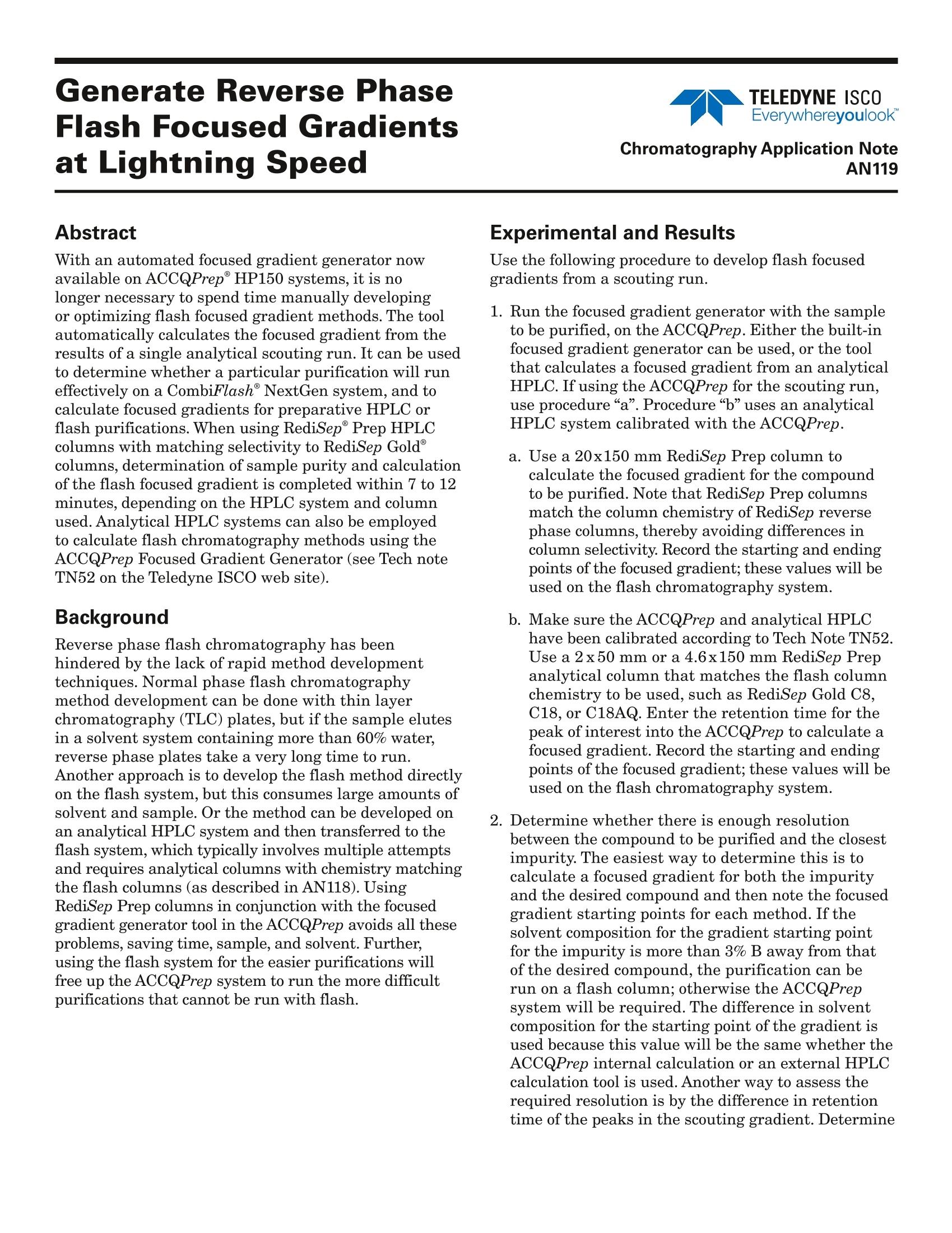

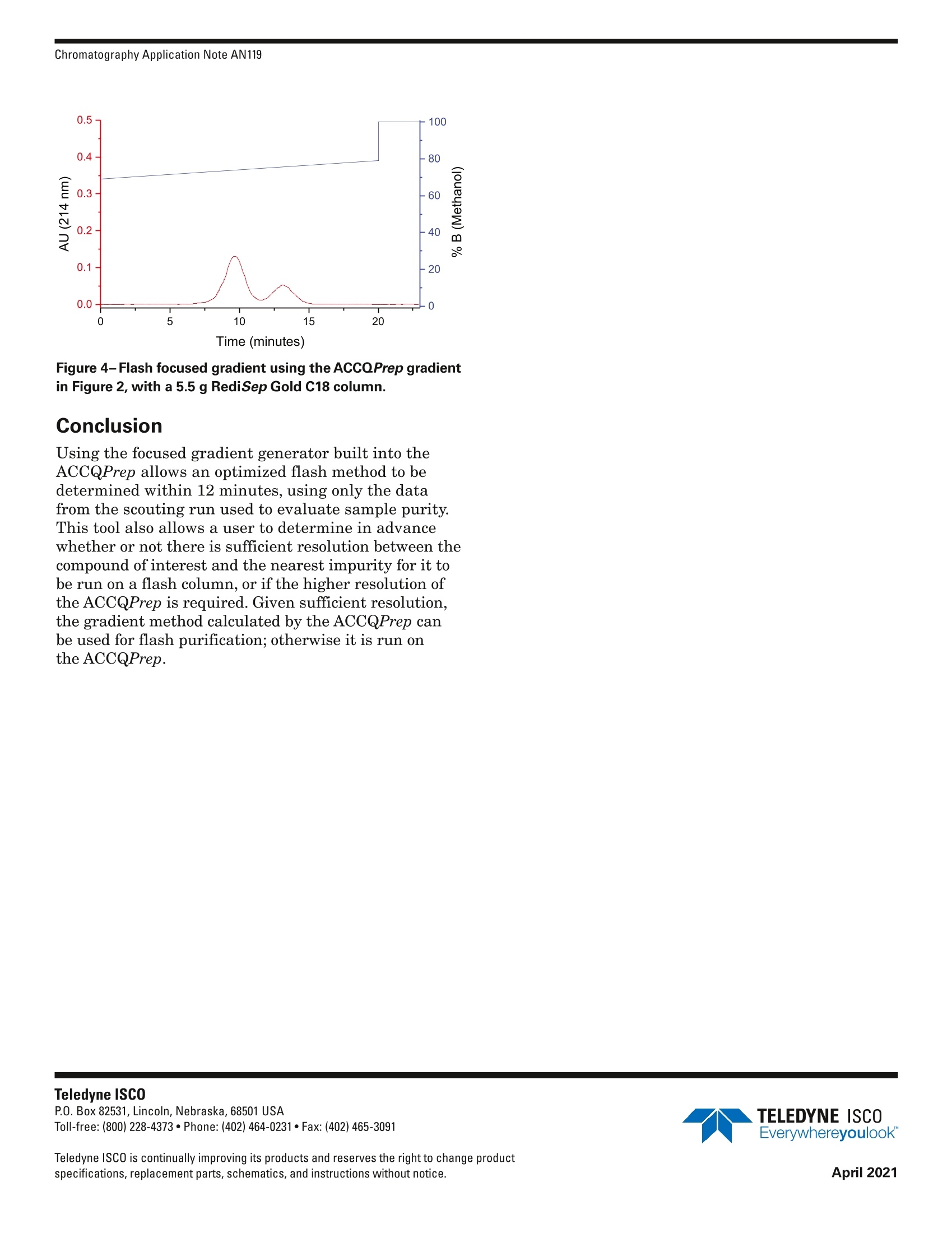
还剩1页未读,是否继续阅读?
培安有限公司为您提供《样品中快速制备聚焦梯度检测方案(制备液相色谱)》,该方案主要用于其他中其他检测,参考标准--,《样品中快速制备聚焦梯度检测方案(制备液相色谱)》用到的仪器有ISCO 快速制备液相色谱仪、ISCO高压液相制备色谱仪
推荐专场
相关方案
更多
该厂商其他方案
更多
